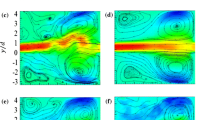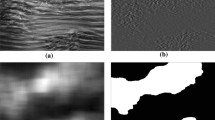Abstract
Quantitative results concerning the modulation of the ejection and bursting frequency in an unsteady channel flow obtained by flow visualizations are presented and compared with probe measurements. The frequency of the imposed velocity oscillations f covers a large range going from the quasi steady limit to the time mean bursting frequency in the corresponding steady flow. The imposed amplitudes of the velocity oscillations are 13% and 20% of the centerline velocity. The bursting process is identified by the intermittent lift up of the dye injected at the wall. Qualitative analysis of the flow visualizations show that the ejection activity at a given phase of the oscillation cycle is repetitive from one cycle to the other. The modulation amplitude of the ejection frequency 〈f e 〉 is sensitive to the imposed frequency. At low imposed frequency 〈f e 〉 is modulated as the wall shear stress, but the inner scaling does not hold when f + is high. Here, (+) corresponds to the quantities normalized with the inner variables, i.e. the friction velocity u τ and the viscosity ν. The grouping of the ejections into bursts show the coexistence of two categories of events which react differently to the forcing. The groups of ejections (Multiple Ejection Bursts) are governed by the modulation of the wall shear stress 〈τ〉 in the whole imposed frequency range. The solitary ejections (or the Single Ejection Bursts) have modulation amplitudes and phases which differ significantly from those of 〈τ〉 in the intermediate and high imposed frequency range. There is a good agreement between the flow visualization data and the probe measurements.
Similar content being viewed by others
References
Bernard PS; Thomas JM; Handler RA (1993) Vortex Dynamics and the Production of Reynolds Stress. J Fluid Mech 253: 385
Blackwelder RF; Kaplan RE (1976) On the Wall Structure of the Turbulent Boundary Layer. J Fluid Mech 76: 89
Blackwelder RF; Haritonidis JH (1983) Scaling of the bursting frequency in turbulent boundary layers. J Fluid Mech 132: 87
Brereton GJ; Reynolds WC; Jayaraman R (1990) Response of a Turbulent Boundary Layer to Sinusoidal Free-Stream Unsteadiness. J Fluid Mech 221: 131
Bogard DG (1982) Investigation of Burst Structures in Turbulent Channel Flows Through Simultaneous Flow Visualization and Velocity Measurements. Ph.D. Thesis Purdue University; Lafayette, U.S.A.
Bogard DG; Tiederman WG (1987) Burst Detection with a Single-Point Velocity Measurements. J Fluid Mech 162: 389
Bogard DG; Tiederman WG (1987) Characteristics of Ejections in Turbulent Channel Flow. J Fluid Mech 179: 1
Brereton GJ; Reynolds WC; Jayaraman R (1990) Response of a Turbulent Boundary Layer to Sinusoidal Free-Stream Unsteadiness. J Fluid Mech 221: 131
Corino E-R; Brodkey S-R. A Visual Investigation of the Wall Region in Turbulent Flow. J Fluid Mech 37, 1
Ersoy S; Walker JDA (1985) Viscous Flow Induced by Counterrotating Vortices. Phys Fluids 28, 2687
Everitt B (1974) Cluster Analysis New York: Wiley
Feng MQ; Tardu S; Binder G (1993) Inner Region of an Unsteady Channel Flow Proceedings of International Symposium on Near Wall Turbulence, Arizona-USA, March, 1993; Elsevier Pub.
Feng MQ (1993) Structure Fine de la Turbulence en Ecoulements Instationnaires Turbulents PhD Thesis, INPG, Grenoble, France
Finnicum D; Hanratty TJ (1988) Influence of Imposed Flow Oscillations on Turbulence PCH PhysicoChemicalHydrodynamics, 10, 585
Hanratty TJ; Adrian RJ; Liu Z-C; Brooke J; Papavassiliou D; McLaughin J (1993) Recent Results on the Structure of Wall Turbulence Proceedings of Ninth Symp. on Turb. Shear Flows, 11-3, Kyoto, Japan, August 16–18,1993
Kasagi N (1988) Structureal Study of Near-Wall Turbulence and its Heat Transfer Mechanism in the Proceedings of Zaric International Seminar on Near Wall Turbulence, May 16–20, 1988; p. 596–619
Kim J; Spalart PR (1987) Scaling of the Bursting Frequency in Turbulent Boundary Layers at Low Reynolds Numbers Phys Fluids, 30, 3326
Lu LJ; Smith CR (1988) Image Processing of Hydrogen Buble Flow Visualization for Quantitative Evaluation of Hairpin-Type Vortices as a Flow Structure of Turbulent Boundary Layers, Rep FM-14, Dept. of ME and Mech, Lehigh University
Luchik TS; Tiederman WG (1987) Time Scale and Structure of Ejections and Bursts in Turbulent Channel Flows J Fluid Mech, 174, 529
Mao Z-X; Hanratty TJ (1986) Studies of the Wall Shear Stress in a Turbulent Pulsating Pipe Flow J Fluid Mech 92, 671
Mao Z-X; Hanratty TJ (1991) Measurement of Wall Shear Rate in Large Amplitude Unsteady Reversing Flows Proceedings of the Eight Symposium on Turbulent Shear Flows, p. 11-1-1; Munich, Germany September 9–11, 1991
Meisel WS (1972) Computer Oriented Approaches to Pattern Recognition New York: Academic Press
Perry AE; Chong MS (1982) On the Mechanism of Wall Turbulence, J Fluid Mech 119, 173
Ronneberger D; Ahrens CD (1977) Wall Shear Stress Caused by Small Amplitude Perturbations of Turbulent Boundary-Layer Flow: An Experimental Investigation J Fluid Mech 83, 433
Robinson SK (1991) The Kinematics of Turbulent Boundary Layer Structure NASA Technical Memorandum 103859
Smith CR; Metzler SP (1983) The Characteristics of Low-Speed Streaks in the Near-Wall Region of a Turbulent Boundary Layer J Fluid Mech 129, p. 27
Smith CR; Walker JDA; Haidari A-H; Sobrun U (1991) On the Dynamics of > Near Wall Turbulence Phil Trans Roy Soc Lond; August, 1991
Sreenivasan KR; Prabhu A; Narasimha R (1983) Zero-crossings in Turbulent Signals J Fluid Mech 137, 251
Talmon AM; Kunen JMG; Ooms G (1986) Simultaneous Flow Visualization and Reynolds-Stress Measurement in a Turbulent Boundary Layer J Fluid Mech 163
Tardu S; Binder G (1989) Ejections and bursts in pulsatile turbulent wall flow; Measurements and visualizations Seventh Symposoum on Turbulent Shear Flows; Stanford University August 21–23, 1989
Tardu S; Binder G; Blackwelder RF (1993) Turbulent Channel Flow Subjected to Large Imposed Velocity Oscillations To appear in J Fluid Mech
Tardu S; Binder G (1993-a) Response of Bursting to Imposed Velocity Oscillations In Revision (J Fluid Mech)
Tardu S; Binder G (1993-b) Response of Turbulence to Imposed Oscillations of High Frequencies Physics of Fluid A, 5(8), 2028
Tardu S; Feng MQ (1993) An Unsupervised Burst Identification Technique with Single Point Measurements In Revision Phys Fluid A
Tiederman WG (1988) Eulerian Detection of Turbulent Bursts in the Proceedings of Zaric International Seminar on Near Wall Turbulence, May 16–20, 1988
Author information
Authors and Affiliations
Rights and permissions
About this article
Cite this article
Tardu, S.F., Feng, M.Q. & Binder, G. Quantitative analysis of flow visualizations in an unsteady channel flow. Experiments in Fluids 17, 158–170 (1994). https://doi.org/10.1007/BF00190913
Received:
Accepted:
Issue Date:
DOI: https://doi.org/10.1007/BF00190913




